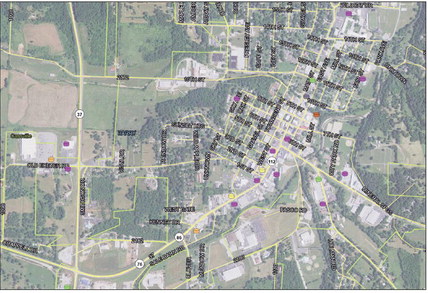Missouri is home to thousands of potentially leaking underground storage tanks (USTs) that contain — or once contained — petroleum and other hazardous substances.
Buried pre-1988, those tanks have long outlived their average 30-year life spans, and now exist, out-of-sight, out-of-mind, in unknown condition, without oversight and not subject to current regulations, said Ken Koon, director of the Tanks Division, of the Missouri Department of Natural Resources (DNR).
Cassville has its share of the underground ghouls.
“The USTs were buried before more stringent tank regulations were enacted in 1988, and were closed in place by the rules that were in effect at the time, which were minimal,” Koon said.
According to current law (post-1988), if a gas station or convenience store closes, their fuel tanks must either be removed from the ground, or emptied and filled with an inert substance such as sand. If evidence of leakage is found, soil and groundwater sampling must be conducted (at the owner’s expense) to assess the damage to the environment, followed by remediation if contamination is found.
Prior to 1988, if a gas station or other business with underground fuel or solvent tanks closed, their tanks could be sealed and left where they were, contents and all.
“No inspection of the site was required, nor were samples of soil and the tanks’ contents taken and recorded,” Ken Koon said.
Thirty-six years later, the old tanks still lurk below the earth’s surface, with today’s generation of prospective home-buyers and renters frequently having no memory or knowledge that fuel-dispensing, automotive repair or other types of businesses that used solvents ever operated near property they’re thinking of buying or renting.
If the tanks were friendly ghosts, their quiet presence could be considered benign. However, according to the Environmental Protection Agency (EPA), until the mid-1980s, most USTs were made of bare, single-walled steel, likely to corrode over time and allow the contents of UST to leak into the environment.
Released from its container, the petroleum or other hazardous substances can contaminate soil and groundwater, where it can pose hazards for drinking water and allow toxic vapors to surface into nearby residences.
Joy Chappell, owner/broker at Flat Creek Realty in Cassville, has been working with a client in another town for several years as he tries to remediate environmental damage from a past fuel leak.
“He wants to sell his property,” she said. “He even had the fuel tank removed, but when they removed it, they discovered the tank had been leaking. Since then, his situation has become a nightmare. They keep drilling monitoring wells to test the groundwater, and lab samples keep coming back showing there’s petroleum in it.”
Faced with this prospective scenario, few property owners where tanks were buried decades ago have any desire to know what lurks below the surface.
In Missouri, if there is known present or past contamination of a property being offered for sale, property owners or their agents are required to disclose the fact to prospective buyers. However, no such obligation applies to hazardous waste sites or potential sources of contamination that exist adjacent to the subject property and beyond.
When little, if anything, is known about the contents and condition of tanks buried before 1988, it compounds the dilemma.
“We do have a regulation that allows us to re-open the site of a UST buried before 1988 if we suspect that it’s impacting nearby properties,” Koon said.
Impacts include the discovery of free-standing regulated substances, contaminated soil or vapors in basements, sewers and utility lines, or in nearby surface and drinking water, by DNR personnel or brought to its attention by another party.
Koon said, however, that the regulation is difficult to implement.
“In practice, if a property owner is uncooperative, it would involve obtaining a search warrant from a judge in order to investigate,” he said. “To do that, there would have to be some pretty solid evidence.
“Even if you and I suspect that a leaking UST might be the source of neighbors’ illnesses, it might not be enough to convince a judge,” he said. “Someone whose property is suspected of being impacted would have to have a soil or water sample done in order to prove the presence of petroleum constituents or other hazardous substances.”
For a neighbor, those types of tests can be costly. The Barry County Health Department does not offer tap water testing for petroleum constituents or other hazardous “organic compounds,” as they’re called. Nor does Missouri’s state lab.
Private labs are costly, if they will do the testing at all. One lab in Springfield gave a quote of over $600 for the general range of constituents associated with petroleum and the solvent trichloroethylene (TCE), but balked when told that it would be a tap water sample from a residence supplied by public water.
“We don’t go to court on behalf of clients,” a lab employee disclaimed, although the possibility of a lawsuit was never mentioned.
Another private lab in Springdale, Ark., refused to even offer a quote after discovering that city water could be involved.
The DNR maintains a registry of underground storage tanks and other hazardous waste sites on its website, where the locations of such prospective environmental hazards are located. After opening the page, click on “View Map,” near the bottom, then fine tune a search by clicking on the specific view options. The number of hazards on the map is impressive, but not exhaustive.
Koon said when regulations changed in 1988, the owners of property with buried and closed tanks were offered a financial incentive in the form of funding available for clean-up if they disclosed the presence of their tanks to the DNR. Department personnel also drove the state to locate old buried tanks.
“Our current registry reflects the tanks that we know about, but we keep learning about more,” Koon said.
Most discoveries are made during real estate transactions, he said.
In addition to the tanks that are discoverable through a search of the DNR’s website, certain prospective property- buyers, lenders and environmental research companies can learn of prospective hazards through Environmental Site Assessments (ESAs) required by lenders on property to be used for commercial or multi-residential purposes. The initial Phase 1 of an ESA includes thorough research of the history of an area where a property is located.
However, even if the Phase 1 shows prospective hazards which could endanger an entire neighborhood, those in possession of the knowledge are not required to disclose their findings to the public, unless the buyer is a governing body and thus subject to the requirements of the Missouri Sunshine Law.
“If a Phase 2 (which includes soil and/or water sampling) on a neighboring property showed some ‘hot’ lab results, we might be able to use those results as evidence for the investigation of a UST site,” Koon said.
The prospects of coming up with such Phase 2 information, however, are tenuous, since they are usually dependent upon acquiring the information from entities who are under no obligation to disclose it.
Cassville is home to several USTs that were buried before 1988. Perhaps the most historic is located at the top of “Tower Hill,” near the intersection of Seventh and Sky Streets, where the city’s first high school once stood. The property is owned by the City of Cassville, and is now home to two water towers.
Public Works director, David Brock, said he believes the old UST, which he’s never seen, was used for fuel oil to heat the school.
On the DNR’s registry, the site is listed as “Fairbanks Scales,” a name which presents yet another mystery to be solved.



